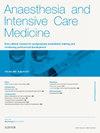神经肌肉功能和传递
IF 0.3
Q4 ANESTHESIOLOGY
引用次数: 0
摘要
了解麻醉或镇静患者神经肌肉功能的生物学过程和机制取决于对运动神经元和神经肌肉连接处肌纤维之间连接的解剖学、生理学和病理学的充分了解。神经肌肉突触的完整性依赖于:通过与运动神经末梢膜活性区融合的突触囊泡的胞外分泌来维持乙酰胆碱的Ca2+依赖性释放;乙酰胆碱对运动终板突触后受体的去极化作用并通过位于突触基底层的乙酰胆碱酯酶的作用终止神经肌肉传递。内稳态机制维持终板电位的大小和神经肌肉传递的安全系数;但神经肌肉连接功能障碍发生在神经肌肉阻滞剂或疾病和其他影响乙酰胆碱释放、作用和失活的情况下。本文章由计算机程序翻译,如有差异,请以英文原文为准。
Neuromuscular function and transmission
Understanding the biological processes and mechanisms underlying neuromuscular function in anaesthetized or sedated patients depends on adequate knowledge of the anatomy, physiology, and pathology of the connections between motor neurons and muscle fibres at neuromuscular junctions. Neuromuscular synaptic integrity depends on: maintenance of Ca2+-dependent release of acetylcholine by exocytosis from synaptic vesicles that fuse with active zones in motor nerve terminal membranes; the subsequent depolarizing action of acetylcholine on postsynaptic receptors at motor endplates; and termination of neuromuscular transmission by enzymic action of acetylcholinesterase located in the synaptic basal lamina. Homeostatic mechanisms sustain the magnitude of endplate potentials and the safety factor for neuromuscular transmission; but dysfunction of neuromuscular junctions occurs following administration of neuromuscular blockers or in diseases and other conditions affecting release, action and inactivation of acetylcholine.
求助全文
通过发布文献求助,成功后即可免费获取论文全文。
去求助
来源期刊

Anaesthesia and Intensive Care Medicine
ANESTHESIOLOGY-
CiteScore
0.50
自引率
0.00%
发文量
152
期刊介绍:
Anaesthesia and Intensive Care Medicine, an invaluable source of up-to-date information, with the curriculum of both the Primary and Final FRCA examinations covered over a three-year cycle. Published monthly this ever-updating text book will be an invaluable source for both trainee and experienced anaesthetists. The enthusiastic editorial board, under the guidance of two eminent and experienced series editors, ensures Anaesthesia and Intensive Care Medicine covers all the key topics in a comprehensive and authoritative manner. Articles now include learning objectives and eash issue features MCQs, facilitating self-directed learning and enabling readers at all levels to test their knowledge. Each issue is divided between basic scientific and clinical sections. The basic science articles include anatomy, physiology, pharmacology, physics and clinical measurement, while the clinical sections cover anaesthetic agents and techniques, assessment and perioperative management. Further sections cover audit, trials, statistics, ethical and legal medicine, and the management of acute and chronic pain.
 求助内容:
求助内容: 应助结果提醒方式:
应助结果提醒方式:


